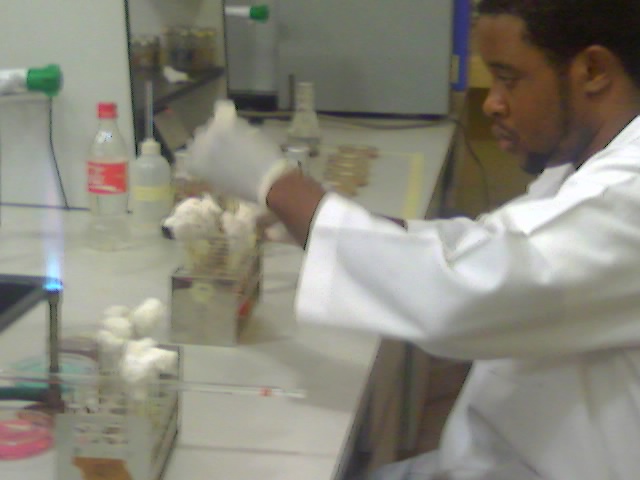Primers are short stretches of DNA that target unique sequences of a DNA molecule and help identify a unique part of a genome or a gene to be copied further. They are usually 18 to 25 nucleotides long. Primers can be synthesized and used for your PCR (polymerase chain reaction) and other molecular biology experiment such as in transformation experiment, gene cloning experiment, gene amplification experiment etc. PCR experiment is a DNA amplification technique in which millions of DNA copies are made using a single DNA segment.
Generally, primers are short pieces of single-stranded DNA molecules that are usually around nucleotides in length. In a PCR experiment, usually two primers are used in each experiment. Each of the two primers (forward primers and reverse primers) are designed in such a way that they flank the target region of the gene sequence to be copied on the template DNA molecule (Figure 1).
The target region to be flanked by the primer(s) is the specific region of the gene sequence that should be copied on the template DNA. Therefore, during primer designs, primers are usually given (nucleotide) sequences (A, G, T, C or U)that will make it easy for the primers to effectively bind to the opposite strands of the unwound (unwinded) double stranded template DNA molecule, and thus continue its extension to produce a new double stranded DNA molecule.
Complementary base pairing is the molecular biology process through which each of the forward and reverse primers bind to each of the single strands of the template DNA molecule (Figure 1). By complementary base pairing we mean that: A (adenine) will always pair with T (thymine) in a double hydrogen bonding while G (guanine) will always pair with C (cytosine) in a three hydrogen bonding. This is what complementary base pairing is all about (Figure 1). Primers are important components of a PCR reaction. A primer is needed to start replication of the lagging strand. The leading strand is replicated by the DNA polymerase in a 3′-5′ direction. This allows the enzyme to travel along the leading strand right behind the helicase. In fact, DNA polymerase can only travel in a 3′-5′ direction.

Subsequently, the lagging strand can’t be replicated in a unidirectional manner (i.e. following right behind the helicase). This means that the DNA polymerase must replicate in the opposite direction (i.e. 3′-5′ because the strands have opposite directions). The DNA polymerase could technically wait for the lagging strand to be completely separated from the leading strand and then commence replication from the 3′ end of the lagging strand.
This, however, would be very inefficient and time-consuming. To solve this type of problem in DNA replication or PCR experiment, primers are used, allowing the DNA polymerase to attach even in the middle of the lagging strand. The area replicated between two primers is called an Okazaki fragment.
To begin the synthesis of a new DNA strand, a short fragment of DNA or RNA known as the primer, must be created and paired with the template DNA strand before the Taq polymerase enzyme can begin the actual process of synthesizing the new DNA strand.
As aforementioned, primers are short DNA fragments (usually about 18-20 bases or nucleotides long) that contain specific sequences which are complementary to the template DNA molecule to be copied and amplified. Two types of primers (i.e. the forward primers and the reverse primers) that are complementary to the 3′ end of each of the double stranded template DNA strands are used in any PCR reaction process.
Forward primers can also be called sense primers while the reverse primers are also known as the anti-sense primers. Primers generally bind to the opposite sides of the template DNA sequence or strands to be amplified during the PCR reaction. They are single-stranded (ss) DNA molecules or oligonucleotides, and they are synthesized by chemical processes.
Primers are also extremely valuable to the technique of PCR. The Polymerase Chain Reaction is a powerful tool in recombinant DNA technology. PCR is a method of amplification of specific DNA segments. A double-stranded DNA molecule that contains the desired sequence is denatured. Oligonucleotide DNA primers are then hybridized to the single strands on either side of the sequence to amplified.
The forward and reverse primers are two different sets of short DNA fragments. Each one is complementary to a specific sequence on one of the strands on the template DNA molecule. The 3′-OH ends of the primers face each other because they have annealed to opposite strands. The primers are then extended by DNA polymerase, creating two new double-stranded DNA molecules, each one containing a copy of the desired sequence or gene.
These new molecules retain the primers. This reaction can be continued to achieve over a million-fold gain in the desired sequence. Primer, in its many different forms, is a very important molecule indeed. Its major role is the one that it performs during DNA synthesis. Without primers, replication of DNA would be impossible. Primers have also found uses in the modern technology of genetics, where they are a powerful and useful tool for gene cloning and transformation experiment.
To design your primers, you can use the Oligo Calc: Oligonucleotide Properties Calculator or the Eurofins genomics calculator or the NIH Primer-BLAST. The following are the three (3) best online primer design tools that you can use to design your primers for your PCR experiment:
Eurofins genomics PRIMER DESIGN TOOL
NIH Primer-BLAST PRIMER DESIGN TOOL
Source
Oligo Calc: Oligonucleotide Properties Calculator. http://www.basic.northwestern.edu/biotools/OligoCalc.html
Eurofins genomics. https://eurofinsgenomics.eu/en/ecom/tools/pcr-primer-design/
http://www-personal.umd.umich.edu/~jcthomas/JCTHOMAS/Student%20Papers%201996/D.Piziali.htm
https://socratic.org/questions/what-is-the-primer-used-for-dna-replication
Discover more from #1 Microbiology Resource Hub
Subscribe to get the latest posts to your email.




This is good.
Thank you for visiting the site!